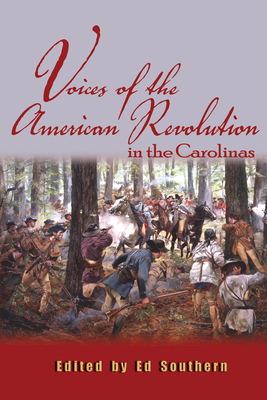Voices of the American Revolution in the Carolinas

Voices of the American Revolution in the Carolinas
On February 11, 1780, a British army led by General Sir Henry Clinton came ashore on Johns Island, South Carolina. By the end of March, the British had laid siege to Charleston, the most important city south of Philadelphia. By the middle of May, they had taken the city and the American army defending it. On March 15, 1781, that same British army left the field at Guilford Courthouse exhausted, decimated, stripped of supplies and rations, and victorious in name only. Its march away from Guilford Courthouse would end only a few months later at Yorktown, Virginia, where it would surrender. How did this happen? Although historians have debated the causes for centuries, they have often ignored how it felt to live, fight, and survive. What was it like to be British or American, Tory or Whig, regular soldier or militia, partisan, outlaw, or would-be bystander as the two sides (and those who drifted from side to side) went at each other with a fury across the Carolina countryside? Through the eyewitness accounts of those who fought the battles and skirmishesVoices of the American Revolution in the Carolinas provides the reader with firsthand looks at how it felt. The entries in this volume are taken from first-person narratives by those on the scene, from officers such as Henry Lee and Banastre Tarleton to teenaged scouts such as Thomas Young and James Collins. Some narratives, like Daniel Morgan's report of the Battle of Cowpens, were written immediately or soon after the action; others, like Young's, were written when the boy soldiers had become old men. Some were written (and sometimes embellished) specifically for publication, while others were written as private correspondence or official reports. Some express a great deal of emotion and describe the authors' immediate experiences of war, while others concentrate on logistics, strategy, tactics, and the practical realities of an army battle; some, like Lee's, manage to do both. The American Revolution in the Carolinas was nasty, brutish, and relatively short, though it must not have felt short to those who lived through it. It moved with a furious swiftness, the center of action shifting from Charleston to Camden, from Charlotte to King's Mountain, and from Cowpens to Guilford Courthouse in a matter of months, weeks, or sometimes days. Accounts that describe what it was actually like at all of these hot spots as well as the events that lead up to the actual fighting are included in this book
PRP: 142.29 Lei
Acesta este Prețul Recomandat de Producător. Prețul de vânzare al produsului este afișat mai jos.
128.06Lei
128.06Lei
142.29 LeiLivrare in 2-4 saptamani
Descrierea produsului
On February 11, 1780, a British army led by General Sir Henry Clinton came ashore on Johns Island, South Carolina. By the end of March, the British had laid siege to Charleston, the most important city south of Philadelphia. By the middle of May, they had taken the city and the American army defending it. On March 15, 1781, that same British army left the field at Guilford Courthouse exhausted, decimated, stripped of supplies and rations, and victorious in name only. Its march away from Guilford Courthouse would end only a few months later at Yorktown, Virginia, where it would surrender. How did this happen? Although historians have debated the causes for centuries, they have often ignored how it felt to live, fight, and survive. What was it like to be British or American, Tory or Whig, regular soldier or militia, partisan, outlaw, or would-be bystander as the two sides (and those who drifted from side to side) went at each other with a fury across the Carolina countryside? Through the eyewitness accounts of those who fought the battles and skirmishesVoices of the American Revolution in the Carolinas provides the reader with firsthand looks at how it felt. The entries in this volume are taken from first-person narratives by those on the scene, from officers such as Henry Lee and Banastre Tarleton to teenaged scouts such as Thomas Young and James Collins. Some narratives, like Daniel Morgan's report of the Battle of Cowpens, were written immediately or soon after the action; others, like Young's, were written when the boy soldiers had become old men. Some were written (and sometimes embellished) specifically for publication, while others were written as private correspondence or official reports. Some express a great deal of emotion and describe the authors' immediate experiences of war, while others concentrate on logistics, strategy, tactics, and the practical realities of an army battle; some, like Lee's, manage to do both. The American Revolution in the Carolinas was nasty, brutish, and relatively short, though it must not have felt short to those who lived through it. It moved with a furious swiftness, the center of action shifting from Charleston to Camden, from Charlotte to King's Mountain, and from Cowpens to Guilford Courthouse in a matter of months, weeks, or sometimes days. Accounts that describe what it was actually like at all of these hot spots as well as the events that lead up to the actual fighting are included in this book
Detaliile produsului










